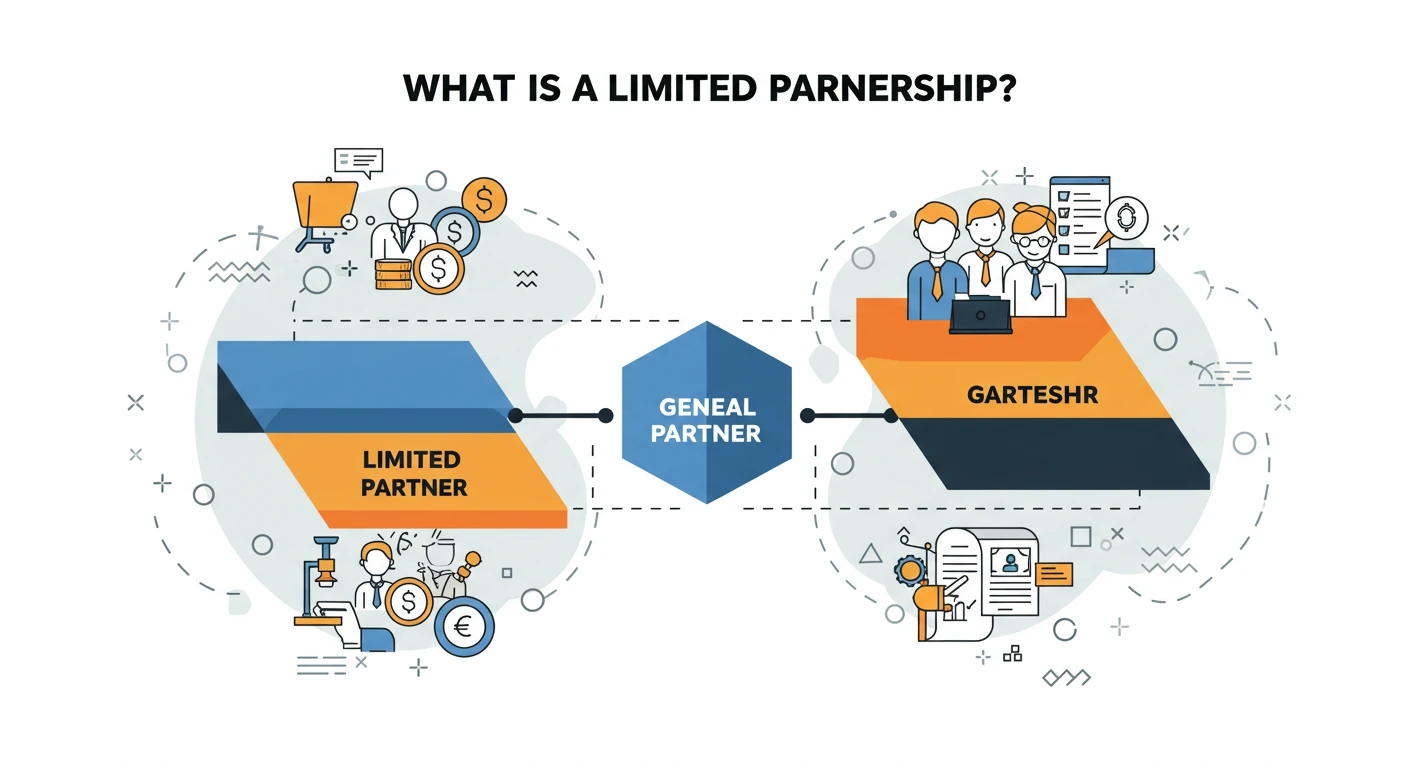Limited Partnership:
A limited partnership (LP) is a business structure in which at least two partners own the company, and only one of those partners is actively involved in its management.
The limited partnership is a hybrid business type that combines traditional partnership features with limited liability protection. There must be at least one general partner who runs the ordinary activities of the partnership and is fully personally liable for all debts of the partnership; the limited partners fund the venture with limited liability exposure. Limited partners are expressly excluded from participating in management and control decisions.
All limited partnerships are required to register with Companies House. Only the partnerships incorporated in Scotland operate as separate legal entities, which means they can hold property and enter into contracts in their name. Limited partnerships attract individuals seeking protection from liability without assuming management responsibilities.
Difference between General and Limited Partners
Limited partnerships operate with two types of limited partners, each with different duties and responsibilities. In a limited partnership, general partners are subject to completion. Personal liability for all business debts and obligations, placing their assets at risk. They control the day-to-day operations, strategic decisions, and all activities of the business without requiring their partner’s consent.
Many general partners are set up as corporations or limited liability partnerships to limit their risk exposure. Limited partners act as passive investors, providing capital for their enjoyment and protection against liability, which is limited to the amount of their investment. They cannot be involved in the management or day-to-day operations; the term “silent partners” is used to describe them.
Investors of this type include pension funds, insurance companies, and wealthy individuals some return on their capital without involvement in operations. Limited partners engage in the management of the business or withdraw their investment before the money is needed, there is a risk that their liability protection will be lost, with partnership debts assigned to them up to the amount withdrawn.
| Feature | General Partner | Limited Partner |
|---|---|---|
| Liability | Unlimited – personally liable | Limited to their investment |
| Business Role | Manages and runs the business | Passive – no management role |
| Decision Making | Has full control | No say in decisions |
| Risk Level | High – personal assets at risk | Low – only invested capital is at risk |
| Profit Share | As per agreement | As per agreement |
| Involvement | Active involvement | Passive/investor only |
| Legal Requirement | Must be registered with Companies House | Must also be registered |
Requirement of the limited partnership
A limited partnership must register for Self Assessment with HMRC and file annual Partnership Tax Returns, exempt from Corporation Tax. Each partner needs to register for self-assessment, declaring their share of the profits and paying personal tax accordingly. If the turnover exceeds £90,000 in 12 months, mandatory VAT registration is required; smaller enterprises may opt to register voluntarily.
Where the general partner is a UK limited company must file accounts with Companies House alongside their company return. In addition to filing annual returns, Scottish limited partnerships are required to maintain registers of Persons with Significant Control; English, Welsh, and Northern Irish partnerships don’t have to comply with these obligations.
Any changes in partnership particulars will have to be notified to Companies House within seven days by way of an LP6 form, including the business name, nature of the activity, address changes, changes in partners, and changes in investments. A Scottish partnership will also have to make a PSC notification within 14 days via paper forms. All notification of changes has to be sent by post.
Clarification on Limited Liability Companies
Limited liability companies (LLCs) are protected by limited liability. The structure of LLCs is simpler and offers flexible management. However, only limited partners enjoy this protection; the assets of general partners remain at risk.
A limited liability company offers flexible tax elections and simpler operational procedures. In contrast, limited partnerships have strict structures, making it easier to raise investments.
Establish a Limited Partnership
To establish a limited partnership between two or more members, registration with Companies House is required. For partnerships in the UK, Wales, and Northern Ireland, you must use form LP5; Scottish partnerships use form LP5.
The application needs to include comprehensive details such as:
- The name of the partnership must end with Limited Partnership
- The nature of the business.
- A registered address for correspondence.
- If applicable, the term is for the duration of the partnership.
The application must include the names and signatures of all general and limited partners, specifying the contributions made by the limited partners, and indicating whether these are in cash or assets. Applications should be submitted by post, accompanied by a £71 registration fee, which can be paid by cheque or postal order.
Once the application is processed, Companies House will issue a certificate of registration. This certificate includes the name and registration number of the partnership, the date of registration, and confirmation under the Limited Partnership Act 1907. The registration process typically takes up to five working days from the date of application; processing times may vary based on the complexity of the application and the number of applications received.
Pros
Limited partnerships are appealing for establishing a business for several key reasons:
- Investor partners are protected from liability; their risk is limited to the amount of capital they contribute.
- Tax obligations for a limited partnership are passed on to the individual partners, so they pay taxes through their returns rather than at the partnership level.
- Managing partners have full authority to operate the business and make decisions without needing approval from the other partners.
- Forming a limited partnership involves fewer regulatory steps compared to most other business structures.
Cons
There are the following disadvantages of limiting partnerships:
- Managing partners have unlimited personal liability for all debts and obligations of the business, putting their assets at risk.
- The structure prevents investor partners from participating in management during difficult times without jeopardizing their limited liability protection.
- This limitation can hinder managing partners from receiving the support they need when facing operational challenges.
- Changing ownership or transferring partnership interests is a complicated process, making it difficult for partners to adjust their involvement or exit the arrangement.
The Required Licenses, Permits, and Insurance Coverage
The required documents and types of insurance can vary significantly depending on the jurisdiction and the type of business. Some states only require limited partnerships to obtain standard business operating licenses before they can begin trading. Industries such as agriculture, mining, and firearms typically need both federal and state licenses to operate legally.
It is essential to verify compliance requirements with all relevant regulatory bodies at the federal, state, county, and local levels. This will provide a clear understanding of the necessary permits and licenses, ensuring that your limited partnership remains compliant with all applicable regulatory frameworks from the outset, avoiding potential legal complications. Proper licensing and insurance coverage not only help maintain compliance with legal requirements but also safeguard the business and protect the interests of its stakeholders.
Conclusion
Limited partnerships offer a balanced business structure combining investment opportunities with clear operational control, making them fit for ventures that require a good deal of capital while still maintaining defined managerial roles. This detailed guide has covered all key aspects regarding limited partnerships, from grasping the distinct responsibilities of general partners and limited partners to registering with Companies House. While limited partnerships give investors considerable liability protection-taxes being highly efficient, they have their downfalls: general partners carry unlimited liability and are subject to significant operational restraints.
Succeeding in this business model will demand thoughtfully implementing risk management practices, licensing and insuring properly, and staying current in compliance with regulatory requirements. With a clear appreciation of both the merits and demerits of limited partnership expounded in this guide, entrepreneurs and investors will be able to make reasoned decisions about the suitability of the limited partnership structure depending on their business expectations and risk level.
















